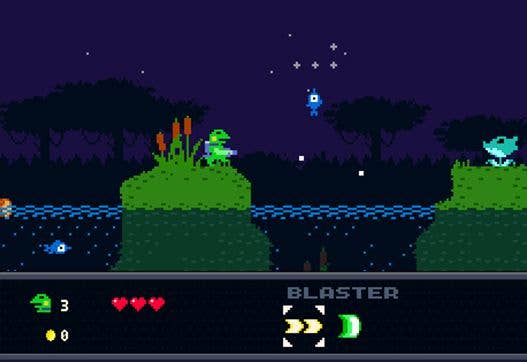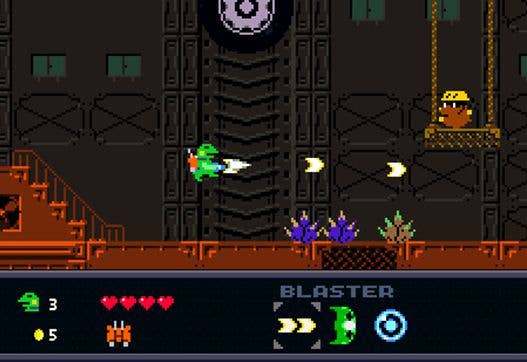Kero Blaster PC Review: This Ain't Cave Story 2
Daisuke Amaya's newest retro-themed game is a very different beast to its predecessor. But is it any good?
This article first appeared on USgamer, a partner publication of VG247. Some content, such as this article, has been migrated to VG247 for posterity after USgamer's closure - but it has not been edited or further vetted by the VG247 team.
Sometimes you play a game and it's clear the creator just loves games. In many cases they're not trying to say anything more complicated than that with their work; they're simply inviting you to share in the joy of play through their creation.
Such is the case with Daisuke "Pixel" Amaya's work, as anyone who played his previous work Cave Story will attest. A modern-day Metroid that combined retro graphics with the subtle refinements of more recent games, Cave Story was a masterpiece that enchanted and enthralled almost everyone who played it. (At least until the true final boss; man, I hated that thing.)
As such, Cave Story was always going to be a hard act to follow, so it's perhaps wise that Pixel chose not to follow it up with a direct sequel. Instead, Kero Blaster is more akin to something like Contra or old-school, pre-Symphony of the Night Castlevanias than anything else -- and, like its predecessor payed loving homage to the NES era, so too does Kero Blaster flawlessly blend a retro aesthetic with a superbly smooth, fluid control scheme that works equally well on keyboard as it does on a gamepad.

In Kero Blaster, you take on the role of a heavily armed frog tasked with clearing weird black furry things off a network of teleporters. You achieve this goal by fighting your way through a series of linear stages, running, gunning and jumping your way to victory. Each stage has at least one boss encounter, and as you progress through the game you'll both collect new weapons to add to your arsenal and upgrade the ones you already own using coins you collect.
The controls are simple, and a big part of why Kero Blaster works so well. Aside from directions, you only have jump, fire and weapon-switching buttons to worry about. Holding down the fire button continues to fire in the direction you were facing when you started shooting, allowing you to, say, move left and right to dodge projectiles while firing directly upwards. Defeating most of the enemies in the game -- both conventional and boss-tier -- requires that you master this technique quickly, but it's so intuitive, straightforward and enjoyable to do that it won't be long before you're pulling off crazy trick shots.
Further refinement in the controls is evident in the way jumping works. A quick tap on the jump button does what you'd expect, but holding it for a little longer launches into a slightly more "floaty" jump that can be used to cover surprisingly large distances. The levels are beautifully designed to take advantage of this mechanic without ever feeling like they're descending into the realms of pixel-perfect accuracy, and you're usually rewarded with something nice for your troubles.

Although this review is primarily based on the PC version, special mention should be given to the excellent implementation of controls on the iOS version. The game is designed in such a way that, although it uses on-screen virtual controls, you'll never have to frantically move your thumbs around too much. There's little in the way of "air control" once you've launched into a jump, for example, and a well-designed directional lever makes locking the direction of your shots a snap. It's clear from the design of the iOS version -- and how well the level design works with the controls -- that Pixel is all too familiar with the frustrations of mobile games, and chose to solve them in an eminently sensible manner without compromising Kero Blaster's depth of gameplay.
The weapons themselves are a lot of fun to use. Beginning with a short-range peashooter that can later be upgraded to a longer-range repeater, you'll gradually acquire quite the arsenal as you progress. A wider-beam wave shot becomes a spread cannon, and a gun that shoots bubbles allows you to either bounce shots down into holes or skim them across the surface of liquids. Pleasingly, it feels like all of the weapons are always useful in different situations: the wide-beam wave shot is good for blasting enemies that half-bury themselves underground before leaping out in an attempt to chew your face off, for example, while the bubbles can effectively allow you to fire around corners and clear a path for yourself before dropping down into perilous territory.
The game also manages to fuse the lives-based structure of an old-school title nicely with the save-happy nature of modern gamers; you have a stock of lives that will deplete as you're defeated, sending you back to your last checkpoint each time, but running out of lives will send you back to the start of the current level without further penalty. You can also save and pick up where you left off at any point rather than having to start all over again each time; it's a nice balance between making death feel meaningful to the player without inconveniencing and frustrating them too much.

The game is beautifully presented. Deliberately low-resolution, low-detail and using few colors, the visuals nonetheless manage to be packed with character and plenty of endearing little details, especially in the animations. Likewise, the sound effects are all authentically "NES-ish" in nature; there are no sampled sound effects throughout, and the music is all synthesized. It all adds up to a lovingly crafted game that authentically channels the aesthetic of the NES era while simultaneously playing like a highly polished modern creation.
The only real criticism of the whole thing is that it's all over far too soon -- a skilled Contra or Castlevania player will likely rip through in a couple of hours, tops, but after that there's a New Game+ mode where you can keep your weapons, and a boss rush where you can challenge yourself to see how quickly you can defeat the game's most fearsome foes. There's also a secret weapon to find and assemble. Even without these extras, though, Kero Blaster would be quite replayable; its short length makes it something you can dip back into every so often and still have an enjoyable experience, even if you know the game inside out. And how many games can you truly say that about these days?
The Nitty Gritty
- Visuals: The deliberately lo-fi art style is used to great effect, supported by more modern effects such as parallax scrolling.
- Music and Sound: The synthesized music is fun and catchy, and the burbling sound effects are authentically 8-bit.
- Interface: Like most Japanese PC games, Kero Blaster lacks native 360 controller support, but the controls are so straightforward (and remappable) that it's not a huge issue.
- Lasting Appeal: Although the game itself is short, it's something you'll find yourself coming back to every so often, such is its charm.
ConclusionAn excellent run-and-gun shooter that plays beautifully on both PC and mobile; the only sticking point for some players will be its relatively short length.
